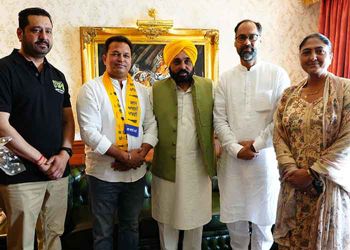
BONE OF CONTENTION: Technology is never cast in stone — the EVM is no exception. ANI
Science Commentator
THE humble electronic voting machine (EVM) is in the news again. Ever since the EVM fully replaced the paper ballot system in the 2004 Lok Sabha elections, it has been a bone of contention among political parties as well as members of civil society in every election season. The arguments for and against the EVM remain the same. Only the players keep changing sides. This time around, Chief Election Commissioner (CEC) Rajiv Kumar has set the ball rolling by poetically defending the voting machine. “Adhoori hasraton ka ilzaam har bar hum par lagaana theek nahin (it is not proper to always blame EVMs for your unfulfilled desires)” — this is the CEC’s message to the critics.
In 2013, the ECI introduced the VVPAT — voter-verified paper audit trail — to assure the voter that his or her vote had been properly recorded.
It is a question about trust in technology. The EVM is a key element of the process of electing people’s representatives, and all stakeholders involved — political parties, voters, civil society — must trust it. Trust is additional to the technology meeting all the legislative, legal, regulatory, cost and technological criteria. This holds good for all new technological products and services. The exchange of money through financial instruments is a good example. When the cheque — a paper-based financial instrument — replaced the Hundi money transfer, people needed to have sufficient trust in the banking system. The same happened when the paper cheque got an alternative — electronic money transfer through banks. And now, we have Internet-based digital money transactions using mobile phones. It involves several unidentified intermediaries, yet billions of digital transactions take place every day. It is not as if the system has no holes, but the users have adequate trust that it would work.
The paper ballot system — which the EVM fully replaced two decades ago — also evolved over a long period. In the first General Election in 1951-52, multiple ballot boxes were used — one for every candidate with each marked with a party’s symbol. Voters had to put their ballot in the box of their choice. Then came a common ballot box and a ballot paper with symbols and names of contesting candidates printed on it. Voters had to stamp the symbol of their choice and deposit the ballot paper in the common box. There were controversies about the reliability and safety of ballot boxes, and incidents of stealing of ballot papers and booth capturing were reported from some parts of the country. The paper ballot system was vulnerable to fraud and yet it enjoyed a reasonable level of trust among all stakeholders for decades.
From the prototype developed by the Hyderabad-based Electronics Corporation of India Limited in 1979 to its nationwide rollout in 2004, the EVM went through many iterations and was subject to intense legal scrutiny and political discourse. Just like the paper ballot, the EVM must satisfy a voter on three counts — a vote cast is properly recorded (it should be transparent to him or her), the vote must go to the candidate intended by the voter, and it should be properly counted and accounted for. This involves not only the integrity of an individual voting unit but the entire chain — from the assembly and programming of the unit to transport, storage (before and after voting) and the counting process. The question of trust in EVMs, therefore, extends beyond trust in the EVM technology and covers the whole chain.
As regards the technology, the Election Commission of India (ECI) has maintained that the EVM is tamper-proof and the technology is incorruptible. On the face of it, this sounds logical. It is a rudimentary machine, is not networked, has no wireless interface and does not use any operating system, unlike advanced voting machines. That's why it is not prone to external hacking, it is argued.
At the height of a public outcry about the integrity of the EVM in 2009, the ECI organised a public challenge for political parties and activists and made available some 100 EVMs to them. However, ECI officials and EVM manufacturers objected to some participants ripping apart the machine. The challenge fizzled out. Later, one of the activists, Hari Prasad, claimed in a television interview that he had privately accessed an EVM and could hack it. The ECI filed a complaint, following which he was arrested. Prasad belonged to a group called Citizens for Verifiability, Transparency and Accountability in Elections, headed by GVL Narasimha Rao, who later became a BJP spokesperson.
The episode showed that the ECI and EVM manufacturers were being opaque about what went inside the machine. Yet, responding to the criticism about the lack of transparency, the ECI introduced in 2013 the VVPAT — voter-verified paper audit trail — to assure the voter that his or her vote had been properly recorded.
While an individual EVM may or may not be hackable by external means, it is far from being foolproof because of the human element involved at the manufacturer’s end. The machine is programmed through a source code that runs on the hardware. Theoretically, it can be programmed in a desired manner. PV Indiresan, a former IIT professor who chaired the ECI’s technical committee in 2005, revealed that “not more than three to four people know the source code”, which is kept secret by the EVM manufacturers (which are public sector units) and that “from their character, we know that they will not disclose the source code”. The question of trust in EVM technology, therefore, hinges on the integrity of those who manufacture EVMs and not on technology only.
The way forward is not a return to the paper ballot, as is being suggested by some. Instead, the ECI must go the extra mile to rebuild the trust of political parties and voters. The exercise should cover every stage of the process — from manufacturing and programming of machines to the storage and counting of votes. Wherever necessary, more trust-building measures like VVPAT should be introduced. For building a greater level of trust, we need a matching level of transparency. Technology is never cast in stone — the EVM is no exception.
Join Whatsapp Channel of The Tribune for latest updates.




























